![]()
![]()
![]()
Use LEFT and RIGHT arrow keys to navigate between flashcards;
Use UP and DOWN arrow keys to flip the card;
H to show hint;
A reads text to speech;
171 Cards in this Set
- Front
- Back
|
describe Bilirubin metabolism
|
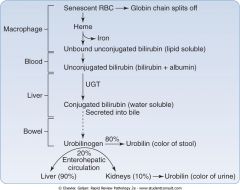
|
|
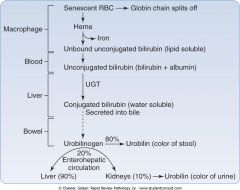
which disorders could have the following lab findings
Increased production of UCB , absent Urine Bilirubin, increase UBG, urobilinogen, |
Extravascular hemolytic anemias: e.g., hereditary spherocytosis, Rh and ABO HDN
|
|
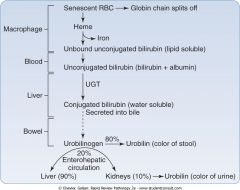
which disorders could have the following lab findings
Decreased uptake or conjugation of UCB , absent Urine Bilirubin, Normal UBG, urobilinogen, |
Gilbert syndrome: common genetic defect in uptake/conjugation of UCB; jaundice occurs with fasting
Crigler-Najjar syndromes: genetic disorders with decreased to absent conjugating enzymes Physiologic jaundice of newborn: begins on day 3 of life; caused by normal macrophage destruction of fetal RBCs |
|

which disorders could have the following lab findings
CB >50% increase Urine Bilirubin, absent UBG, urobilinogen, |
Decreased intrahepatic bile flow Drug-induced (e.g., OCP)
Primary biliary cirrhosis Dubin-Johnson syndrome: genetic defect in secretion into intrahepatic bile ducts; black pigment in hepatocytes Rotor's syndrome: similar to Dubin-Johnson syndrome but without black pigment in hepatocytes Decreased extrahepatic bile flow Gallstone in common bile duct Carcinoma of head of pancreas |
|
|
name the component of bilirubin metabolism
Senescent red blood cells (RBCs) are phagocytosed by splenic macrophages. end product of heme degradation. is lipid-soluble. |
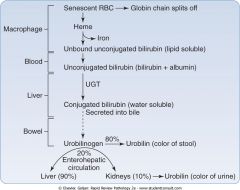
Unconjugated bilirubin (UCB)
UCB is the end product of heme degradation. |
|
|
name the component of bilrubin metabolism
combines with albumin in the blood |
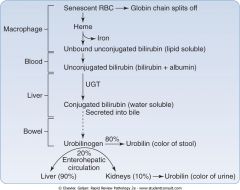
Unconjugated bilirubin (UCB)
|
|
|
name the compent of bilirubin metabolism
UCB is taken up by hepatocytes. and then UCB is conjugated to produce which product |
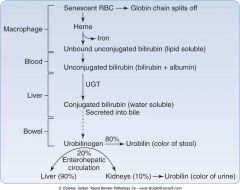
onjugated bilirubin (CB).
CB is water-soluble. |
|
|
which components of bilirubin metabolism is the following
Temporarily stored in the gallbladder Enters the duodenum via the common bile duct |
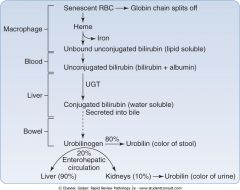
Conguated Bilirubin is secreted into the intrahepatic bile ducts.
|
|
|
name the component of bilirubin metabolism
Intestinal bacteria convert CB to which product |
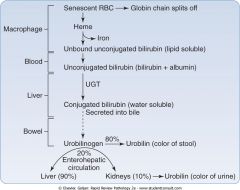
Intestinal bacteria convert CB to urobilinogen (UBG).
|
|
|
what causes jaundice and what are the signs
|
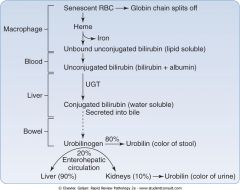
Jaundice is due to an increase in UCB and/or CB.
Jaundice is first noticed in the sclera. |
|
|
name the component of the liver function test
Specific enzyme for liver cell necrosis Present in the cytosol |
Serum alanine transaminase (ALT)
|
|
|
name the condition with the following component of the liver function test
ALT >AST: |
viral hepatitis
|
|
|
name the component of the liver function test
Present in mitochondria Alcohol damages mitochondria |
Serum aspartate transaminase (AST)
|
|
|
name the condition in with the component of the liver function test
AST >ALT |
indicates alcoholic hepatitis
|
|
|
name the component of the liver function test
Intra- or extrahepatic obstruction to bile flow Induction of cytochrome P-450 system |
Serum γ-glutamyl transferase (GGT)
|
|
|
name the classic condition with component of the liver function test
increases GGT |
alcoholic liver
|
|
|
describe the component of the liver function test
Normal GGT and increased ALP-Serum alkaline phosphatase (ALP) |
source of ALP other than liver (e.g., osteoblastic activity in bone)
|
|
|
name the condition with component of the liver function test
Increased GGT and ALP: |
liver cholestasis
|
|
|
name the condition with component of the liver function test
Urine bilirubin present in excess |
Bilirubinuria: viral hepatitis, intra- or extrahepatic obstruction of bile ducts
|
|
|
name the condition with component of the liver function test
excess Urine UBG |
Increased urine UBG: extravascular hemolytic anemias, viral hepatitis
Absent urine UBG: liver cholestasis |
|
|
where is Albumin is synthesized
|
liver
|
|
|
where are the Majority of coagulation factors are synthesized
|
in the liver
|
|
|
what does increase Prothrombin time (PT) indicate
|
Increased PT: severe liver disease
|
|
|
where does the Urea cycle take place
|
liver
|
|
|
what does a decrease in Blood urea nitrogen (BUN) indicate
|
cirrhosis
|
|
|
where is Ammonia metabolized
|
Ammonia is metabolized in the urea cycle
|
|
|
what does Increased serum ammonia indicate
|
cirrhosis, Reye syndrome
|
|
|
Serum IgM is increased in which GI condition
|
Increased in primary biliary cirrhosis
|
|
|
Antimitochondrial antibody is present in which GI condition
|
primary biliary cirrhosis
|
|
|
An antimicrosomal antibody is an antibody directed against microsomes.In which conditions is it associated with
|
Hashimoto's thyroiditis
|
|
|
Anti-smooth muscle antibody is present in which GI condition
|
Autoimmune hepatitis
|
|
|
α-Fetoprotein (AFP) is a tumor marker for which GI condition
|
Hepatocellular carcinoma
|
|
|
name the condition
Fever, painful hepatomegaly Serum transaminases increase steadily. Peak just before jaundice occurs Atypical lymphocytosis |
Viral Hepatitis
|
|
|
what are the urine bilirubin and urine UBG findings in viral hepatitis
|
Increased urine bilirubin and urine UBG
|
|
|
Microscopic findings in acute viral hepatitis include councilman bodies.. what are they
|
Apoptosis of hepatocytes (Councilman bodies)
|
|
|
name the type of hepatitis and how it is transmitted
No carrier state Does not lead to chronic hepatitis Occurs in day care centers, prisons, travelers to developing countries, and male homosexuals (anal intercourse) |
Hepatitis A - fecal /oral
|
|
|
name the type of hepatitis and how it is transmitted
Carrier state may occur Chronic hepatitis in 10% of immunocompetent patients Serum sickness prodrome (5-10%): vasculitis (PAN), polyarthritis, membranous GN Increased incidence of hepatocellular carcinoma |
Hepatitis B Parenteral, sexual, vertical (pregnancy, breast feeding)
|
|
|
name the type of hepatitis and how it is transmitted
Carrier state may occur Mild hepatitis; jaundice uncommon Chronic hepatitis in >70% of cases Associated with posttransfusion hepatitis, type I MPGN, alcohol excess, PCT Increased incidence of hepatocellular carcinoma |
Hepatitis C Parenteral, sexual
|
|
|
name the type of hepatitis and how it is transmitted
Carrier state may occur Requires HBsAg to replicate Chronic state less likely with coinfection (HBV and HDV exposure at same time) than superinfection |
Hepatitis D Parenteral, sexual
|
|
|
name the type of hepatitis and how it is transmitted
No carrier state or chronic hepatitis Fulminant hepatitis may develop in pregnant women Occurs in developing countries |
Hepatitis E Fecal-oral (waterborne)
|
|
|
what are the finding in Earliest phase of acute HBV
|
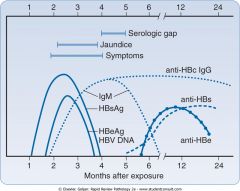
HBsAg, hepatitis B surface antigen only
|
|
|
what are the serological findings in Acute infection of Hepatitis B
|
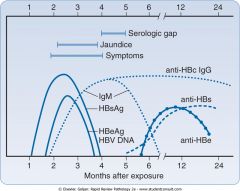
1. Hepatitis B surface antigen (HBsAg)
2. Hepatitis B e antigen (HBeAg) and HBV-DNA Infective particles Appear after HBsAg and disappear before HBsAg 3. Anti-HBV core antibody IgM (anti-HBc-IgM)-Nonprotective antibody Remains positive in acute infections |
|
|
what is the First marker of infection with Hepatitis B and when does it appear after infection
|
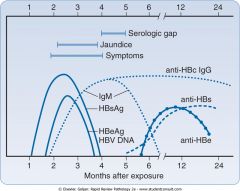
Hepatitis B surface antigen (HBsAg)
Appears within 2 to 8 weeks after exposure |
|
|
Anti-HBV core antibody IgM (anti-HBc-IgM) converts to what in 6 months
|
Converts to anti-HBc-IgG in 6 months
|
|
|
Window phase, or serologic gap of Heptatis B contains which marker
|

Anti-HBV core antibody IgM (anti-HBc-IgM) ONLY
Nonprotective antibody |
|
|
what serological marker provides that Protective antibody against Hepatitis B
|
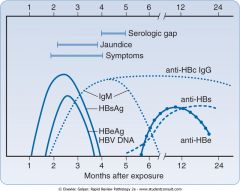
Anti-HBV surface antibody (anti-HBs)
|
|
|
which marker would indicate immunization after HBV vaccination
|

Anti-HBV surface antibody (anti-HBs)
ONLY |
|
|
what seroligical marker would indicate Recovered from HBV
|
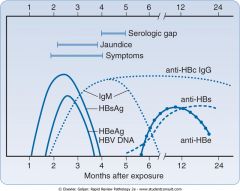
1. Anti-HBV surface antibody (anti-HBs)
and 2. anti-HBc-IgG |
|
|
what serological marker would indicate
"Healthy" carrier if HBsAg >6 months |
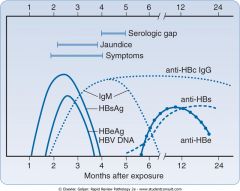
Presence of HBsAg and anti-HBc-IgG
and Absence of DNA and e antigen |
|
|
what serological markers would indicate Infective chronic carrier of hepatitis B. what is the pt at increased risk for developing
|
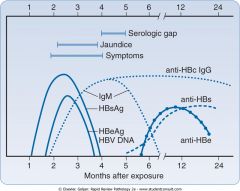
Presence of HBsAg, anti-HBc-IgG, and infective particles (DNA and e antigen)
Increased risk for postnecrotic cirrhosis and hepatocellular carcinoma |
|
|
Hepatitis C virus (HCV) is Screened with which modality. HCV is confirmed with which modality
|
Screen with enzyme immunoassay
Presence of anti-HCV-IgG indicates infection or recovery. Confirmatory tests Recombinant immunoblot assay (RIBA) HCV RNA using polymerase chain reaction |
|
|
t/f anti-HCV-IgG a protective antibody.
|
FALSE- anti-HCV-IgG indicates infection or recovery.
It is not a protective antibody. |
|
|
t/f Presence of anti-HDV-IgM or IgG indicates a protective antibody.
|
false- Hepatitis D virus (HDV)
Presence of anti-HDV-IgM or IgG indicates active infection. IgG is not a protective antibody. |
|
|
t/f Presence of anti-HEV-IgM indicates recovery and protective antibody
|
true- Hepatitis E virus (HEV)
Presence of anti-HEV-IgM indicates active infection. Anti-HEV-IgG indicates recovery (protective antibody). |
|
|
how does conjugated bilirubin gain access to blood to increase the content
|
CB gains access to blood via damaged bile ductules.
|
|
|
Increased urine UBG and urine bilirubin
is present in Viral hepatitis: defect in uptake, conjugation of UCB and secretion of CB. How does urine UBG and uring bilirubin gain access to urine |
CB is water-soluble and is filtered in the kidneys.
UBG recycled back to inflamed liver is redirected to the kidneys. |
|
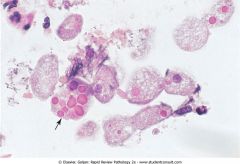
name the pathogen that causes the following Infectious Diseases of the Liver
Usually right lobe abscess |
Entamoeba histolytica
|
|
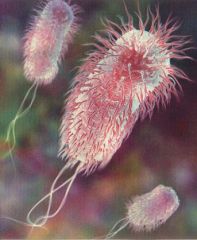
name the pathogen of Infectious Diseases of the Liver
Inflammation of bile ducts (cholangitis) from concurrent biliary infection and duct obstruction (e.g., stone) Triad of fever, jaundice, right upper quadrant pain Most common cause of multiple liver abscesses |
e. coli
|
|
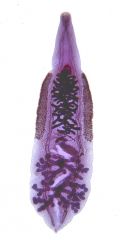
name the pathogen that produces the following Infectious Diseases of the Liver
Contracted by ingesting encysted larvae in fish; larvae enter common bile duct and become adults May produce cholangiocarcinoma |
Clonorchis sinensis (Chinese liver fluke)
|
|
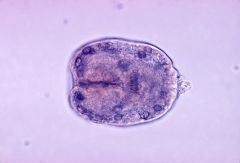
name the pathogen that produces the following infectious disease of the liver
Single or multiple cysts containing larval forms Dog is definitive host; human is intermediate host Rupture of cysts can produce anaphylaxis |

Echinococcus granulosus (sheepherder's disease)
|
|
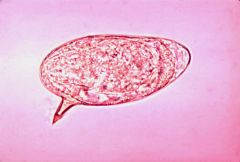
name the pathogen that produces the following liver disease
Eggs incite a fibrotic response in the portal vein ("pipestem cirrhosis") Complications of cirrhosis: portal hypertension, ascites, and esophageal varices |

Schistosoma mansoni
|
|
|
name the condition
Clinical findings Fever, jaundice, hepatosplenomegaly Laboratory findings Positive serum antinuclear antibody (ANA) test Anti-smooth muscle antibodies |
Autoimmune hepatitis
|
|
|
name the condition
Usually develops in children younger than 4 years of age Often follows a chickenpox or influenza infection |
Reye syndrome
|
|
|
name the condition
Microvesicular type of fatty liver- Small cytoplasmic globules without nuclear displacement Clinical findings Encephalopathy Cerebral edema, coma, convulsions Hepatomegaly |
Reye syndrome
|
|
|
name the condition
Hypertension, proteinuria, dependent pitting edema in third trimester Liver cell necrosis around portal triads Increased serum transaminases |
Preeclampsia
|
|
|
describe the HELLP syndrome
|
Hemolytic anemia with schistocytes
Elevated serum transaminases Low platelets-Due to disseminated intravascular coagulation |
|
|
name the condition
Acute liver failure with encephalopathy within 8 weeks of hepatic dysfunction |
Fulminant hepatic failure
|
|
|
what are the Gross , microscopic and clinical findings in Fulminant hepatic failure
|
Wrinkled capsular surface due to loss of hepatic parenchyma
Dull red to yellow necrotic parenchyma with blotches of green (bile) Clinical findings Hepatic encephalopathy and jaundice |
|
|
what are the Laboratory findings in Fulminant hepatic failure
|
Decrease in transaminases-Liver parenchyma is destroyed.
Increase in PT and ammonia |
|
|
why is Liver infarction is uncommon
|
because of a dual blood supply:
Hepatic artery and portal vein tributaries normally empty blood into the sinusoids |
|
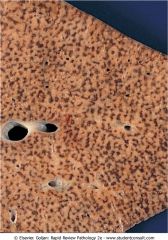
which condition can lead to this presentation in the liver
Centrilobular hemorrhagic necrosis |
("nutmeg" liver). The liver has a mottled cut surface. Dark areas represent congested central veins and sinusoids.
Most often due to left-sided heart failure (LHF) and right-sided heart failure (RHF) LHF decreases cardiac output causing hypoperfusion of the liver. Causes ischemic necrosis of hepatocytes located around central vein RHF causes a back-up of systemic venous blood into the central veins and sinusoids. |
|
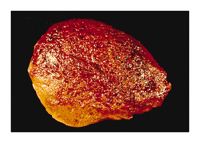
name the condition
Sinusoidal dilation due to blood Causes Anabolic steroids Bartonella henselae causing bacillary angiomatosis - Occurs in AIDS Potential for intraperitoneal hemorrhage |

Peliosis hepatis
|
|
|
name the condition and give 2 examples
Obstruction of blood flow out of the liver |
Posthepatic obstruction to blood flow
Hepatic vein thrombosis Veno-occlusive disease |
|
|
list 3 causes of Hepatic vein thrombosis leading to Posthepatic obstruction to blood flow causing:
Enlarged, painful liver Portal hypertension, ascites, splenomegaly High mortality rate |
Polycythemia vera
Oral contraceptive pills Hepatocellular carcinoma- Invades hepatic vein |
|
|
name a condition that would lead to Veno-occlusive disease producing Posthepatic obstruction to blood flow
|
Complication of bone marrow transplantation
Collagen develops around the central veins. |
|
|
why is Fatty liver change is the most common type of disease seen in Alcohol-related disorders
|
Substrates of alcohol metabolism are used to synthesize liver triglyceride.
|
|
|
describe the pathogenesis of Alcoholic hepatitis
|
Due to acetaldehyde damage to hepatocytes
Stimulation of collagen synthesis around the central vein Perivenular fibrosis |
|
|
what are the 3 Microscopic findings in Alcoholic hepatitis
|
1. Fatty change with neutrophil infiltration
2. Mallory bodies- Damaged cytokeratin intermediate filaments in hepatocytes 3. Perivenular fibrosis |
|
|
name the tumor or disease associated with Chemical- or drug-induced liver disease
Vinyl chloride, arsenic, thorium dioxide (radioactive contrast material) |
Angiosarcoma
|
|
|
name the tumor or disease associated with Chemical- or drug-induced liver disease
Thorium dioxide-used as a stabilizer in tungsten electrodes in TIG welding, electron tubes, and aircraft engines |
Cholangiocarcinoma
|
|
|
name the tumor or disease associated with Chemical- or drug-induced liver disease
Aflatoxin (due to Aspergillus mold) |
Hepatocellular carcinoma
|
|
|
name the tumor or disease associated with Chemical- or drug-induced liver disease
Oral contraceptive pills |
Liver cell adenoma or Cholestasis
|
|
|
name the tumor or disease associated with Chemical- or drug-induced liver disease
Isoniazid (caused by toxic metabolite), halothane, acetaminophen, methyldopa |
Acute hepatitis
|
|
|
name the tumor or disease associated with Chemical- or drug-induced liver disease
Oral contraceptive pills (estrogen interferes with intrahepatic bile secretion), anabolic steroids |
Cholestasis
|
|
|
name the tumor or disease associated with Chemical- or drug-induced liver disease
Amiodarone (resembles alcoholic hepatitis; Mallory bodies and progression to cirrhosis), methotrexate |
Fatty change or fibrosis in the liver
|
|
|
what is the difference between Intrahepatic cholestasis and Extrahepatic cholestasis
|
Intrahepatic cholestasis
Blockage of the intrahepatic bile ducts Extrahepatic cholestasis Blockage of common bile duct (CBD) |
|
|
Drugs (e.g., oral contraceptive pills, anabolic steroids, Neonatal hepatitis
Pregnancy-induced cholestasis (estrogen) produce which Type of cholestatic liver disease |
Intrahepatic cholestasis
|
|
|
Stone usually originating from the gallbladder, Primary sclerosing pericholangitis, Extrahepatic biliary atresia and Carcinoma head of pancreas most likely produce which Type of cholestatic liver disease
|
Extrahepatic cholestasis
|
|
|
the Clinical findings of obstructive liver disease include jaundice. what causes the jaundice
|
Jaundice with pruritus
Pruritus due to bile salts deposited in skin |
|
|
the Clinical findings of obstructive liver disease include Malabsorption. descibe why
|
Malabsorption
Bile salts do not enter the small intestine. |
|
|
the Clinical findings of obstructive liver disease include Light-colored stools. why
|
Due to a lack of urobilin
|
|
|
what are the Laboratory findings in obstructive liver disease
|
CB >50%
Bilirubinuria Absent urine UBG Increase in serum ALP and GGT |
|
|
name the condition
Obliterative fibrosis of intrahepatic and extrahepatic bile ducts Male dominant Associated with ulcerative colitis Clinical findings Jaundice Cirrhosis Increased incidence of cholangiocarcinoma |
Primary sclerosing pericholangitis
|
|
|
name the condition
Irreversible diffuse fibrosis of the liver with formation of regenerative nodules |
Cirrhosis
|
|
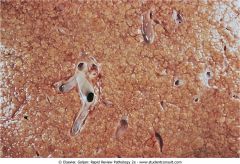
describe the gross appearance of this cirrhotic liver
|
Hepatocyte reaction to injury -diffuse micronodular surface of the liver.
Lack normal liver architecture Lack of portal triads and sinusoids Surrounded by bands of fibrosis Compress sinusoids and central veins Intrasinusoidal hypertension Reduction in the number of functional sinusoids Increase in hydrostatic pressure in portal vein |
|
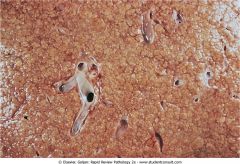
list 4 causes of this type of liver
|
1. Alcoholic liver disease (most common)
2. Postnecrotic cirrhosis (HBV, HCV) 3. Autoimmune disease (primary biliary cirrhosis) 4. Metabolic disease: Hemochromatosis, Wilson's disease α1-Antitrypsin deficiency, galactosemia |
|
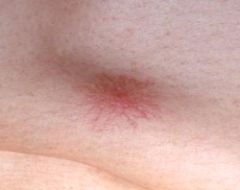
desribe the common condition that produce this symptom
|

spider angioma (telangiectasia) on the cheek of a patient with cirrhosis.
Multiple spider angiomas are common in cirrhosis and pregnancy. |
|
|
why does hepatic failure lead to Multiple coagulation defects
|
Due to inability to synthesize coagulation factors
Produces a hemorrhagic diathesis |
|
|
why does hepatic failure produce dependent pitting edema and ascites
|
Hypoalbuminemia from decreased synthesis of albumin
|
|
|
what cause the Hepatic encephalopathy
in hepatic failure |
1. Increase in aromatic amino acids (e.g., phenylalanine, tyrosine, tryptophan)- Converted into false neurotransmitters (e.g., gamma aminobutyric acid)
2. Increase in serum ammonia Due to a defective urea cycle that cannot metabolize ammonia |
|
|
what are the Clinical findings in hepatic encephalopathy due to hepatic failure
|
Alterations in the mental status
Somnolence and disordered sleep rhythms Asterixis (i.e., inability to sustain posture, flapping tremor) Coma and death in late stages |
|
|
describe the Pathogenesis of portal hypertension
|
Resistance to intrahepatic blood flow due to intrasinusoidal hypertension
Anastomoses between portal vein tributaries and the arterial system |
|
|
describe 5 Complications of portal hypertension
|
1. Ascites
2. Congestive splenomegaly- Increased hydrostatic pressure in splenic vein. Hypersplenism with various cytopenias may occur 3. Esophageal varices 4. Hemorrhoids, 5. periumbilical venous collaterals (caput medusae) |
|
|
what cause the Hyperestrinism in males
with liver cell failure |
Liver cannot degrade estrogen and 17-ketosteroids (e.g., androstenedione).
Androstenedione is aromatized into estrogen in the adipose cell. |
|
|
name the condition
Autoimmune disorder Granulomatous destruction of bile ducts in portal triads Occurs more often in women between 40 and 50 years of age Progresses from a chronic inflammatory reaction to cirrhosis |
Primary biliary cirrhosis (PBC)
|
|
|
name the condition
Pruritus- Deposition of bile salts in skin. EARLY finding well before jaundice appears Hepatomegaly Jaundice- LATE finding after most of the bile ducts have been destroyed Cirrhosis with portal hypertension Increased risk for hepatocellular carcinoma |
Primary biliary cirrhosis (PBC)
|
|
|
name the condition
Laboratory findings Antimitochondrial antibodies (>90% of cases) Increase in IgM |
Primary biliary cirrhosis (PBC)
|
|
|
name the condition
Complication of chronic extrahepatic bile duct obstruction Example-cystic fibrosis, where bile is dehydrated No increase in antimitochondrial antibodies or IgM |
Secondary biliary cirrhosis
|
|

describe the The normal function of the HFE gene produc
|
to facilitate the binding of plasma transferrin (binding protein of iron) with its mucosal cell transferrin receptor so that transferrin can be endocytosed by intestinal cells. The amount of endocytosed transferrin iron determines how much mucosal cell iron is released into the plasma.
this pic-Liver biopsy stained with Prussian blue in a patient with hereditary hemochromatosis. The hepatocytes are filled with blue iron granules. This is an early stage before parenchymal damage and fibrosis develop. |
|
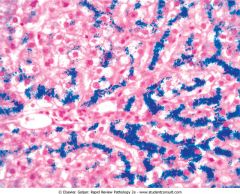
describe the pathogenesis of hereditary hemochromatosis
|
1. Unrestricted reabsorption of iron in the small intestine
2. Mutations involving hereditary hemochromatosis gene (HFE) 3. Iron stimulates the production of hydroxyl free radicals-Free radicals damage tissue and cause fibrosis. |
|
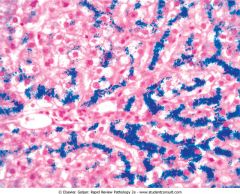
in which organs does iron from
hereditary hemochromatosis deposit other than The hepatocytes are filled with blue iron granules |
Liver, pancreas, heart, joints, skin, pituitary
|
|
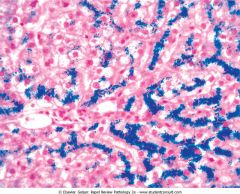
describe the clinical findings in pt with hereditary hemochromatosis (6)
|
1. Cirrhosis- Iron deposits primarily in hepatocytes . Increased risk of hepatocellular carcinoma
2. "Bronze diabetes"- Type I diabetes mellitus. Destruction of β-islet cells 3. Hyperpigmentation- Iron deposits in skin and increases melanin production 4. Malabsorption- Destruction of exocrine pancreas 5. Restrictive cardiomyopathy, degenerative joint disease 6. Increased serum iron, percent saturation, and ferritin |
|
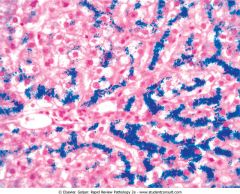
why is there a Decreased in total iron-binding capacity in pt with hereditary hemochomatosis
|
Transferrin synthesis is decreased when iron stores are increased
|
|
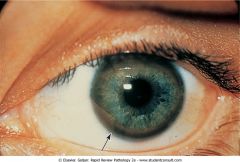
describe the pathogenesis of this disorder
|
1. Gene mutation- AR- Defective hepatocyte transport of copper into bile for excretion. Decreased synthesis of ceruloplasmin (binding protein for copper in blood)
2. Unbound copper eventually accumulates in blood Loosely attached to albumin Copper deposits in other tissues causing a toxic effect. |
|
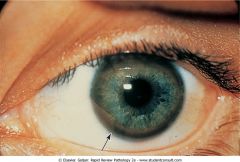
what causes the Kayser-Fleischer ring
in Wilson's disease |
Due to free copper deposits in Descemet's membrane in the cornea
The gene defect in Wilson's disease affects a copper transport system that produces a dual defect-decreased synthesis of ceruloplasmin in the liver and decreased excretion of copper into bile. |
|
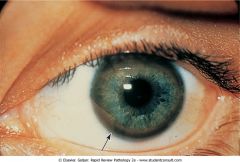
what causes the Central nervous system symptoms in Wilson's
|
Copper deposits in the putamen
Produces a movement disorder resembling parkinsonism Copper deposits in the subthalamic nucleus- Produces hemiballismus Copper is toxic to neurons in the cerebral cortex- Produces dementia |
|
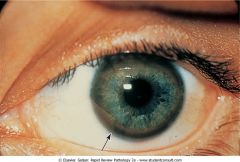
what is Useful in diagnosing Wilson's disease in its early stages
|
Decreased serum ceruloplasmin
|
|
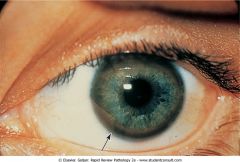
what is Useful in diagnosing Wilson's disease in the later stages
|
Increased serum and urine free copper
|
|
|
name the condition and describe the pathogensis
Neonatal hepatitis with intrahepatic cholestasis Most common cause of cirrhosis in children Increased risk for hepatocellular carcinoma Young adults with panacinar emphysema |
α1-Antitrypsin (AAT) deficiency
Alleles are inherited codominantly (each allele expresses itself). Normal genotype is PiMM. Most common abnormal allele is Z. PiZZ variant has decreased AAT levels in serum. Production of a mutant protein that cannot be secreted into blood Accumulation of AAT in hepatocytes causes liver damage. |
|
|
what causes the Decreased serum blood urea nitrogen (BUN) and increased serum ammonia in cirrhosis
|
Due to disruption of the urea cycle in the liver
|
|
|
what causes the Fasting hypoglycemia
in cirrhosis |
Defective gluconeogenesis and decreased glycogen stores
|
|
|
name the condition and describe the pathogensis
Neonatal hepatitis with intrahepatic cholestasis Most common cause of cirrhosis in children Increased risk for hepatocellular carcinoma Young adults with panacinar emphysema |
α1-Antitrypsin (AAT) deficiency
Alleles are inherited codominantly (each allele expresses itself). Normal genotype is PiMM. Most common abnormal allele is Z. PiZZ variant has decreased AAT levels in serum. Production of a mutant protein that cannot be secreted into blood Accumulation of AAT in hepatocytes causes liver damage. |
|
|
what cause the Chronic respiratory alkalosis in cirrhosis
|
Toxic products from hepatic dysfunction overstimulate respiratory center
|
|
|
what causes the Decreased serum blood urea nitrogen (BUN) and increased serum ammonia in cirrhosis
|
Due to disruption of the urea cycle in the liver
|
|
|
what causes the Lactic acidosis in cirrhosis
|
Liver dysfunction in converting lactic acid to pyruvate
|
|
|
what causes the Fasting hypoglycemia
in cirrhosis |
Defective gluconeogenesis and decreased glycogen stores
|
|
|
what cause the Chronic respiratory alkalosis in cirrhosis
|
Toxic products from hepatic dysfunction overstimulate respiratory center
|
|
|
what causes the Lactic acidosis in cirrhosis
|
Liver dysfunction in converting lactic acid to pyruvate
|
|
|
in what pt population is Liver (hepatic) cell adenoma most commonly seen and why
|
Benign tumor of hepatocytes
Usually occur in women of childbearing age Associated with the use of oral contraceptive pills |
|
|
in what pt population is Liver (hepatic) cell adenoma most commonly seen and why
|
Benign tumor of hepatocytes
Usually occur in women of childbearing age Associated with the use of oral contraceptive pills |
|

Hepatocellular carcinoma. Multiple large, hemorrhagic tumor masses are present in the liver. There is also diffuse infiltration of tumor blending in with the remaining liver.
list 3 causes |
1. chronic HBV and HCV
2. Aflatoxins (from Aspergillus mold in grains and peanuts) 3. Hereditary hemochromatosis, alcoholic cirrhosis, PBC, AAT deficiency |
|
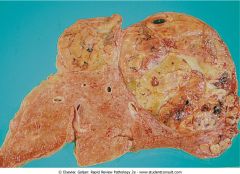
what is the characteristic microscopic finding in Hepatocellular carcinoma.
|
characteristic finding is the presence of bile in neoplastic cells.
|
|
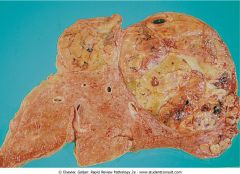
list 3 important Laboratory markers for heptocellluar carcinoma
|
1. Increased α-fetoprotein (AFP)
2. Production of ectopic hormones Erythropoietin (secondary polycythemia) Insulin-like factor (hypoglycemia) |
|
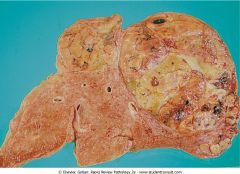
what is the most common site for metastasis of a hepatocellular carcinoma
|
Lung most common metastatic site
|
|
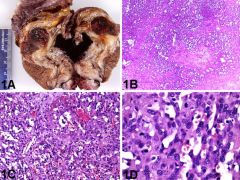
Exposure to vinyl chloride (most common cause), arsenic, or thorium dioxide increases the risk for which type of cancer
|
Angiosarcoma
|
|
|
name the cystic disease
most common cyst in biliary tract in children younger than 10 years old Clinical findings Abdominal pain with persistent or intermittent jaundice |
Choledochal cyst
|
|
|
name the cystic condition
AR Segmental dilatation of intrahepatic bile ducts Clinical findings Association with polycystic kidney disease Increased incidence of cholangiocarcinoma |
Caroli disease
|
|
|
name the condition
Most common malignancy of bile ducts Clinical findings Obstructive jaundice Palpable gallbladder (Courvoisier's sign) |
Cholangiocarcinoma
|
|

name 4 cause of Causes of cholangiocarcinoma
|
1. Primary sclerosing pericholangitis
Most common cause in United States 2. Clonorchis sinensis (Chinese liver fluke) 3. Thorotrast (thorium dioxide) 4. Choledochal cyst and Caroli disease |
|
|
(80% of cases) Gallstones (cholelithiasis)
They are radiolucent |
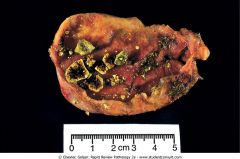
Yellow cholesterol stones with centers containing entrapped bile pigments. The wall of the gallbladder is scarred
|
|
|
name the type of gallstone
Black and brown pigment stones Some are radiopaque. |
Pigment stones
|
|
|
name the type of gallstone
Black and brown pigment stones Some are radiopaque. |
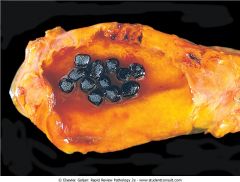
Pigment stones
|
|
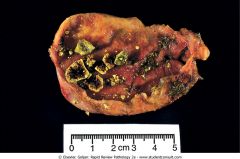
describe the pathogenesisi
|
Supersaturation of bile with cholesterol
Decreased bile salts and lecithin Both normally solubilize cholesterol in bile |
|

describe the pathogenesis
|
black pigment stones -Sign of chronic extravascular hemolytic anemia (e.g., sickle cell anemia)
Excess bilirubin in bile produces calcium bilirubinate Brown pigment stones Sign of infection in the Collecting Bile Dut |
|
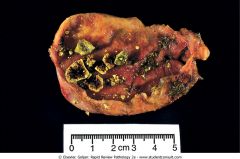
what are the risk factors
|
4 F's
Female over 40 years old Obesity Cholesterol is increased in bile. Use of oral contraceptive pills Estrogen increases cholesterol in bile. Rapid weight loss, use of lipid-lowering drugs Native Americans (e.g., Pima and Navajo Indians) |
|
|
name the condition
Fever with nausea and vomiting Usually 15 to 30 minutes after eating Initial midepigastric colicky pain Pain eventually shifts to the right upper quadrant. Pain is constant and dull Pain may radiate to right scapula |
Acute cholecystitis
|
|
|
what is the GOLD standard for testing for gall stones
|
Ultrasound is the gold standard
Radionuclide scan identifie |
|
|
name the condition
Severe, persistent pain 1 to 2 hours postprandially Recurrent epigastric distress, belching, and bloating |
Chronic cholecystitis
Pathogenesis Cholelithiasis with repeated attacks of minor inflammation |
|
|
name the condition
Gallbladder with dystrophic calcification Dominant in elderly women Poor prognosis |
Gallbladder adenocarcinoma
|
|
|
name the condition
Dorsal and ventral buds form a ring around the duodenum. Associated with small bowel obstruction |
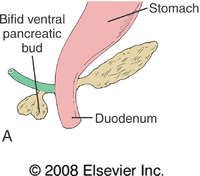
Annular pancreas
|
|
|
describe how the Major pancreatic duct and CBD are confluent in their terminal part
|
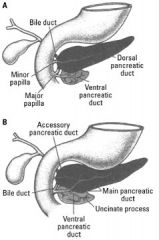
Both empty their contents into the duodenum via the ampulla of Vater
|
|
|
describe the Important in the pathogenesis of acute pancreatitis
|
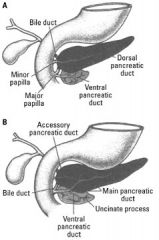
Stone(s) obstruct terminal part of the CBD →
Increased back-pressure refluxes bile into the major pancreatic duct → Bile activates pancreatic proenzymes causing acute pancreatitis |
|
|
t/f an increase in amylase is specific for pancreatitis
|
false- increase in amylase is not specific for pancreatitis
|
|
|
what are the 2 major causes of acute pancreatitis
|
Alcohol abuse and gallstones are the major causes
|
|
|
what are the 2 major causes of acute pancreatitis
|
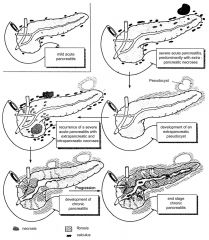
Alcohol abuse and gallstones are the major causes
|
|
|
describe the pathogenesis of acute pancreatitis
|
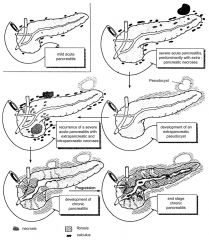
Must be activation of pancreatic proenzymes (inactive enzymes)-Activation leads to autodigestion of the pancreas
Mechanisms of activation of proenzymes a. Obstruction of the main pancreatic duct or terminal CBD b. Gallstones c. Alcohol thickens ductal secretions Also increases duct permeability to enzymes d.Chemical injury of acinar cells Examples-thiazides, alcohol, triglyceride (>1000 mg/dL) e. Infectious injury of acinar cells Examples-CMV, mumps, coxsackievirus f. Mechanical injury of acinar cells Examples-seat belt trauma, posterior penetration of duodenal ulcer Metabolic activation of proenzymes (e.g., hypercalcemia, ischemia, shock) Trypsin is important in the activation of proenzymes. |
|
|
name the condition
fever, nausea and vomiting Severe, boring midepigastric pain with radiation into the back Radiation into back is due to its retroperitoneal location. |
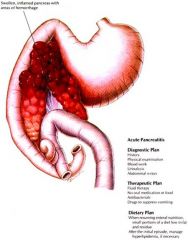
acute pancreatitis
|
|
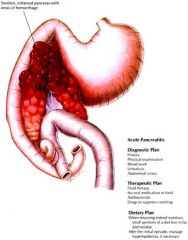
what causes the shock in acute pancreatitis
|
Due to hemorrhage and loss of enzyme-rich fluid around the pancreas (called "third spacing")
|
|
|
what causes the Hypoxemia in acute pancreatitis
|
Circulating pancreatic phospholipase destroys surfactant.
Loss of surfactant produces atelectasis and intrapulmonary shunting. Acute respiratory distress syndrome (ARDS) may occur. |
|
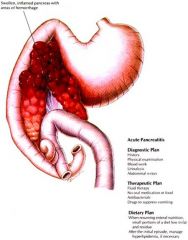
what causes the Hypoxemia in acute pancreatitis
|
Circulating pancreatic phospholipase destroys surfactant.
Loss of surfactant produces atelectasis and intrapulmonary shunting. Acute respiratory distress syndrome (ARDS) may occur. |
|
|
what are Grey-Turner's signand Cullen's sign in acute pancreatitis
|
Grey-Turner's sign (flank hemorrhage), Cullen's sign (periumbilical hemorrhage)
|
|
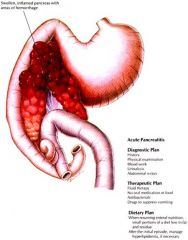
what causes the Tetany in acute pancreatitis
|
Hypocalcemia is caused by enzymatic fat necrosis.
Calcium binds to fatty acids leading to a decrease in ionized calcium. |
|
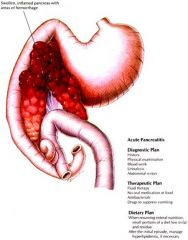
what lab findings are specific for acute pancreatitis
|
Increased serum lipase
More specific for pancreatitis Serum levels return to normal in 3 to 5 days. Is not excreted in urine |
|
|
what is the gold standard for pancreatic imaging.
|
Computed tomographic (CT) scan is the gold standard for pancreatic imaging.
Plain abdominal radiograph Sentinel loop in subjacent duodenum or transverse colon (cut-off sign) Localized ileus, where the bowel does not demonstrate peristalsis Left-sided pleural effusion containing amylase (10% of cases) |
|
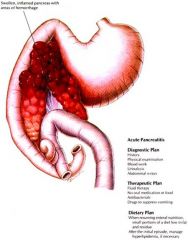
Complications of acute pancreatitis include Pancreatic pseudocyst. describe thise pseudocysts
|

Collection of digested pancreatic tissue around pancreas
Abdominal mass with persistence of serum amylase longer than 10 days Amount of amylase in the fluid surpasses renal clearance of amylase. |
|
|
list the common causes of Chronic pancreatitis in adults, children, and developing countries
|
Alcohol abuse is the most common known cause.
Cystic fibrosis is the most common cause in children. Malnutrition is the most common cause in developing countries. |
|
|
name the condition
Radiographic dyes show a "chain of lakes" appearance in the pancreatic major duct. Pancreatic calcifications (CT scan best study) Clinical findings Severe pain radiating into the back Malabsorption Type 1 diabetes mellitus Pancreatic pseudocyst |
Chronic pancreatitis
|
|
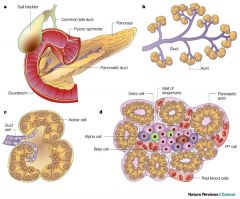
what causes Exocrine pancreatic cancer
|

Smoking (most common cause)
Chronic pancreatitis Hereditary pancreatitis |
|
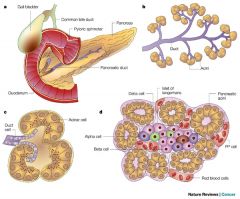
describe the Pathogenesis of exocrine pancreatic cancer
|
Association with K-RAS gene mutation
Mutation of suppressor genes (TP16 and TP53) |
|

what is the location of most exocrine pancreatic cancers
|
Most occur in the pancreatic head (65% of cases)
Often blocks CBD causing jaundice Remainder occur in the body and tail |
|
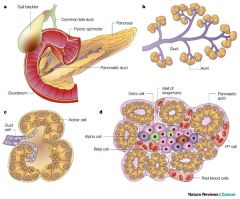
what are the clinical and lab findings of exocrine pancreatic cancer
|

Epigastric pain with weight loss
Signs of CBD obstruction (carcinoma of head of pancreas) Jaundice (CB > 50%) Light-colored stools (absent UBG) Palpable gallbladder (Courvoisier's sign) Superficial migratory thrombophlebitis (see Chapter 8) Increased CA19-9 Gold standard tumor marker |

